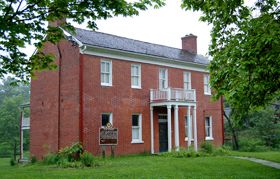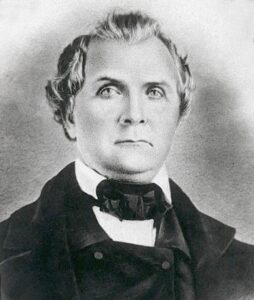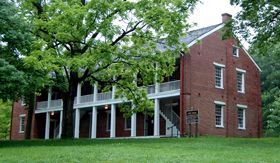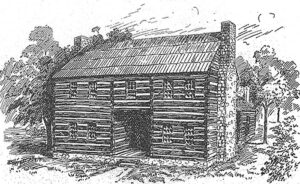The Shawnee Methodist Mission in Fairway, Kansas, was established by missionaries to minister to the Shawnee tribe.
Through a treaty initiated in 1825, the Shawnee Indians were moved from their homes in Ohio and Missouri to a reserve established in Kansas. Five years later, Reverend Thomas Johnson established the Shawnee Methodist Mission in 1830 in the old Turner community (in present-day Kansas City, Kansas). The mission served both the Shawnee and Delaware tribes until 1839. At that time, the Reverend Johnson felt that if they moved the mission and built a new school for the Indians, it would serve more tribes. So, in 1839, the mission was relocated to a site on the Santa Fe Trail. The first building was completed in October 1839 and was utilized for classrooms and living quarters for teachers. Today, the building still stands and is called the West Building.
Construction of a second building began immediately, which provided yet more classrooms and living quarters. This building, called the East building today, was completed in 1841. A third building, called the North Building, was completed in 1845. It served as a dormitory and classrooms for Indian girls. The school taught the boys basic academics, manual arts, agricultural courses, and domestic skills to the girls.
Over the years, children from several tribes attended, including the Kanza, Munsee, Delaware, Ottawa, Chippewa, Otoe, Osage, Cherokee, Peoria, Kickapoo, Potawatomi, Wea, Gros Ventre, Omaha, and Wyandot. For the next two decades, the school taught classes six days a week to children aged 5 to 23.
The mission grounds grew to accommodate as many as 200 students. At its height of activity, it covered some 2,000 acres, upon which sat farms, gardens, and 16 buildings, including a wagon shop, blacksmith shop, wash house, stables, smokehouse, barn, spring house, and more. The mission also had its own steam grist and sawmill. When the children were not in school, the girls helped with the domestic chores of the mission, while the boys assisted in the shops and on the farm.
In 1854, when Kansas Territory was established, Andrew Reeder, the newly-appointed territorial governor, had his offices at the mission in what is known as the North Building today. That same year, the manual training portion of the school ceased, but it continued to teach academics to the children.
The following year, the first Territorial Legislature met for the first time on July 2-6, 1855, at the newly established capital in Pawnee. During this first session, a cholera epidemic broke out in the town of Pawnee. The legislators, most of whom were pro-slavery men from Missouri, alarmed at the epidemic and already dissatisfied with the distance they had to travel to the capital, quickly passed a bill for an adjournment of the session to the Shawnee Mission in Johnson County. Though Governor Andrew Reeder vetoed the bill, the legislature overrode his veto and adjourned.
The second capital of Kansas then became the Shawnee Mission on July 16. It served as territorial capital until the spring of 1856, during which time the legislatures enacted numerous pro-slavery laws that sparked the Bleeding Kansas violence. These politicians and sessions would later become known as the Bogus Legislature.
When the politicians moved their sessions to yet another state capitol in Lecompton, life at the school returned to normal, at least for a little while. In 1858, the Reverend Thomas Johnson turned the school over to his oldest son, Alexander, who ran the mission until it closed in 1862. During the Civil War, the site and its buildings were utilized as a camp for Union soldiers.
A few years later, the Reverend Thomas Johnson, who had moved to Missouri, was murdered by Southern sympathizers on January 2, 1865. Though Johnson was a previous slaveholder who sided firmly with the pro-slavery group, he signed a Unionist pledge when the Civil War broke out. This angered many Missourians.
He was buried in the Shawnee Methodist Mission cemetery, along with several family members. The old cemetery still stands three blocks east of Mission Road on Shawnee Mission Parkway.
After the Civil War, the mission property was owned by several individuals until the State of Kansas acquired it in 1927. Since that time, it has been administered by the Kansas Historical Society. The site, which maintains the largest three brick structures, which once served as living quarters and classrooms for Indian students, became a National Historic Landmark in 1958.
Today, the state historic site is a museum featuring exhibits on Kansas Indians, agents, and missionaries, Kansas settlement, overland trails, the Kansas-Missouri Border War, and the Civil War.
More Information:
Shawnee Mission State Historic Site
3403 West 53rd Street
Fairway, Kansas 66205 (near Kansas City)
913-262-0867
© Kathy Alexander/Legends of America, updated February 2024.
Also See:




